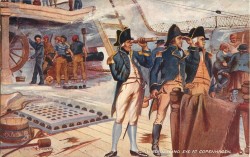By LCDR Adam Kahnke and LT Scott Cheney-Peters
In our first post Scott and I wrote about education opportunities available for those supporting the U.S. Navy, from reserve Marine Corps to active Navy to civil servants. We’ve updated that post with additional options thanks to RADM James Foggo, CDR Stephen Melvin, Chrissy Juergens, LCDR Vic Allen, and Tetyana Muirhead. In that article we focused on free courses that can be used towards degrees or certificate programs. But that’s not the only type of free training available.
Alternatively, you might find yourself in the situation “Degreed Out” (BSEE, MBA, CDFM, CISSP, OA Cert from NPS…), in which getting another master’s degree or certification may start merely seeming like alphabet soup. Also, if you’re like me and you find yourself on shore duty, it should be a time for professional and personal development, right? I tried something different and took a few classes through Coursera. Six classes actually, and I’m happy to say this was a very positive and rewarding experience. Coursera offers what are known as massive open online courses (MOOCs). In contrast with the courses in our first post, these typically have no limit on the number of seats in the class and some can be started at any time, although there are many variations on the set-up. While they too don’t charge for enrollment, a few have a small fee to test or “certify” you upon the course’s completion if that is something you’d like to pursue.
With Coursera each class ranged from 6-12 weeks in length and all required a different but not insignificant amount of work. What did I get for my efforts you ask? All but one of the courses offered me PDF certificates of completion that don’t mean much to anyone but me. More importantly, I learned more than I thought possible in subject matters I chose (Cryptography, Reverse Engineering of Malware, Financial Engineering, Computational Finance, High Performance Computing and Guitar) by the experts in the field (Stanford, University of London International Programmes, University of Washington, Columbia University, Georgia Tech, and Berklee School of Music).
In my humble opinion, this is the future of education. I think this is the greatest invention since the public library system. It is the public library system and the internet combined, with guided direction of the world’s greatest instructors thrown into the mix. I am convinced that this is how the world will judge future academic institutions and decide where they will send their children to study full-time. It is also quite possibly, how future college students will prepare and choose their degree paths. I expect great things for the future due largely to efforts such as these. For Scott’s part, he believes the business model will allow MOOCs to count towards degree and certificate programs at “brick-and-mortar” institutions if they are individually partnered with that institution and upon the successful completion of testing on a fee basis (The Economist has covered the possible future of MOOCs in more depth, as well as even shorter, less-formal learning tools).
Massive Open Online Courses (MOOCs)
For an aggregation of MOOC courses across these and other sites check out MOOC-List.
Coursera
 Coursera has 554 institutions offering course-work in various subject areas. Take the world’s best courses for free and earn a certificate of completion. Alternatively, pay a few dollars extra and earn a verified certificate. This certificate verifies your identity by using methods such as your typing patterns and using an online camera to verify your picture. One of the downsides for military members attempting to take Coursera classes related to your job is that the site is not compatible with NMCI’s old browsers.
Coursera has 554 institutions offering course-work in various subject areas. Take the world’s best courses for free and earn a certificate of completion. Alternatively, pay a few dollars extra and earn a verified certificate. This certificate verifies your identity by using methods such as your typing patterns and using an online camera to verify your picture. One of the downsides for military members attempting to take Coursera classes related to your job is that the site is not compatible with NMCI’s old browsers.
iTunesU
iTunesU has a large collection of free podcasts in several knowledge areas. Not surprisingly, if you want to learn how to write an iTunes App this is the place to go. It seems that may universities have their own portal on the iTunesU website. In my opinion, Apple’s decision to host individual portals has left this site a bit of a mess and course material is slightly unorganized. However, once you find the content you are looking for, it could make your commute to work much more productive.
Udacity
While I have yet to try this one, Udacity is the same basic concept as Coursera but with a twist. You can take the classes completely on your schedule. Although limited in number by comparison, the course offerings looked fairly attractive. I think I may just try the “Intro to Hadoop and Map-reduce” course if I can squeeze it in. With no deadlines it is much more likely that I will sign up, poke around at the most interesting content, and if I am not completely enamored put it off until another day.
edX
 edX is another top-tier MOOC which at the time of this writing has 38 courses to choose from, provided in partnership with such institutions as Harvard, MIT, and Georgetown, spanning many subject areas. Most edX course videos are provided by means of YouTube and do their best to incorporate students into discussion groups on online forums. edX also offers certificates of completion, some requiring a fee for identify verification.
edX is another top-tier MOOC which at the time of this writing has 38 courses to choose from, provided in partnership with such institutions as Harvard, MIT, and Georgetown, spanning many subject areas. Most edX course videos are provided by means of YouTube and do their best to incorporate students into discussion groups on online forums. edX also offers certificates of completion, some requiring a fee for identify verification.
Navy Knowledge Online, MarineNet, and Joint Knowledge Online
We would be remiss if we didn’t mention these three sites, which are in fact long-running DoD-restricted versions of MOOCs. While they may not have the best reputation and are saddled with clunky, non-mobile interfaces, they do offer training on topics directly related to professional duties. Additionally, for those seeking to expand their knowledge beyond their designator or rate, there’s a range of interesting coursework available – from drone operations to intel “A” school to short cultural backgrounds on dozens of countries.
Defense Acquisition University (DAU), FEMA, DHS, Defense Security Service
Back in our first post we talked about (at least in the updated version) accredited courses and certificate options available through DAU, FEMA, DHS at NPS, DHS at Texas A&M, and the Defense Security Service’s Center for Development of Security Excellence. As a reminder, they have many online training options there for self-edification as well. Offerings typically focus on subject such as incident response management, cyber security, and counter-terrorism.
Languages
While Rosetta Stone used to be available free to servicemembers, that contract has since expired. However, there are still several options for beginning or furthering a language for free. Both NKO and JKO have several languages available, but they’re not the most interactive, and focus primarily on a few of the high-demand target languages and militarily useful skills. That said, if you’re already an intermediate speaker or going on a specific assignment and want to brush up on your ability to talk to your uniformed counterparts, these could be quite useful. iTunesU has a plethora of options, running from minute-long immersion to more structured serial listening podcasts. For those with smartphones there are a variety of free language apps that I have yet to try, but the Duolingo app comes highly recommended and takes an immersion and gamification approach to try and cram learning for fun into the nooks and crannies of your free time. Scott may have to put away The Simpsons Tapped Out and finally get back to his Spanish studies.
If you have any additional recommendations on language learning options, please let us know and we’ll perhaps come up with a part 3. In the meantime let us know what else we missed, and keep on learnin’.
This article was cross-posted by permission from JO Rules.
LCDR Vincent “Adam” Kanhnke is a Navy Campaign Analyst, submarine warfare officer, and runs the site www.cricx.org. He is a graduate of the University of Minnesota and the U.S. Naval Post-graduate School.
LT Scott Cheney-Peters is a surface warfare officer in the U.S. Navy Reserve and the former editor of Surface Warfare magazine. He is the founder and vice president of the Center for International Maritime Security (CIMSEC), a graduate of Georgetown University and the U.S. Naval War College, and a member of the Truman National Security Project’s Defense Council.








 How risk can be good, and why we need more of it
How risk can be good, and why we need more of it